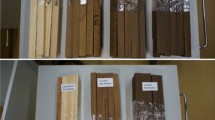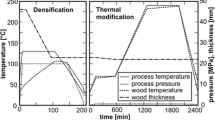Abstract
The mechanical and physical properties of modified timber were assessed by experimental work. The timber was modified using three different methods: acetylation with acetic anhydride, modification with methylated melamine formaldehyde resin and heat treatment in an oil bath. The wood material was sapwood of Scots pine (Pinus sylvestris) with dimensions of 45×70×1100 mm. A total of 99 specimens were included in this study. The following properties and their inter-relations were studied: density, modulus of elasticity (MOE), bending creep deflection and relative creep. It was found that all the modifications successfully reduced the relative creep. However, the performance properties of modified timber ought not to be calculated on the basis of density, as is the case for untreated wood. On the other hand, the long-term performance of modified timber can be assessed by its initial MOE and the difference in equilibrium moisture content (EMC) between two climates.
Zusammenfassung
Die mechanischen und physikalischen Eigenschaften von modifziertem Kiefernschnittholz wurden experimentell bestimmt. Das Schnittholz wurde mit drei verschiedenen Methoden modifiziert: Acetylierung mit Essigsäureanhydrid, Modifizierung mit methyliertem Melaminformaldehydharz und Hitzebehandlung im Ölbad. Das Probematerial war Kiefernsplintholz (Pinus sylvestris) mit den Abmessungen 45×70×1100 mm. Insgesamt wurden 99 Proben getestet. Die folgenden Eigenschaften und deren Korrelationen wurden untersucht: Dichte, dynamischer und statischer Elastizitätsmodul, Kriechverformung im Biegeversuch und relatives Kriechen. Alle Modifikationen reduzierten das relative Kriechen erheblich. Verwendungsrelevante Eigenschaften von modifiziertem Holz sollten nicht anhand der Dichte bewertet werden wie bei unbehandeltem Holz. Andererseits kann die Kriechverformung von modifiziertem Holz anhand seines Elastizitätsmoduls und dem Unterschied in der Ausgleichsholzfeuchte zwischen zwei Klimata abgeschätzt werden.
Similar content being viewed by others
References
van Acker J, Stevens M (1998) The impact of resin treatment on the mechanical properties of solid wood. Paper for the Workshop on Mechanical performance of non-standard wood, COST E8 Conference Mechanical Performance of Wood and Wood Products, Florence, Italy
Bengtsson C (2001) Mechano-sorptive bending creep of timber – influence of material parameters. Holz Roh- Werkst 59:229–236
Bengtsson C, Kliger R (2003) Bending creep of high-temperature dried spruce timber. Holzforschung 57:95–100
Boyd J (1982) An anatomical explanation for viscoelastic and mechano-sorptive creep in wood and effect of loading rate on strength. In: Baas P (ed) New perspectives in Wood Anatomy. Nijhoff & Junk, Hague, pp 171–222
Deka M, Saikia CN, Baruah KK (2002) Studies on thermal degradation and termite resistant properties of chemically modified wood. Bioresource Technol 84:151–157
Eaton RA, Hale MDC (1993) Wood – Decay, Pests and Protection. Chapman and Hall, pp 1–4
Epmeier H (2003) Properties of chemically modified wood. Thesis for the degree of licentiate of engineering. Chalmers University of Technology, Göteborg, Sweden
Hanhijärvi A (1995) Modelling of creep deformation mechanisms in wood. Doctoral thesis. Technical Centre of Finland, VTT publications 301, Espoo, Finland
Hauška M, Bučar B (1996) Mechano-sorptive creep in adult, juvenile and reaction wood. In: Proceedings of the International COST 508 Wood Mechanics Conference, Stuttgart, Germany
Hoffmeyer P, Davidson P (1989) Mechano-sorptive creep mechanism of wood in compression and bending. Wood Sci Tech 23:215–227
Ilic J (2001) Relationship among the dynamic and static elastic properties of air-dry Eucalyptus delegatensis R. Baker. Holz Roh- Werkst 59:169–175
Jermer J, Bengtsson C, Brem F, Clang A, Ek-Olausso B, Edlund M (2003) Heat-treated wood – durability and technical properties. SP Report 2003:25. Borås, Sweden
Kamdem DP, Pizzi A, Jermannaud A (2000) Durability of heat-treated wood. Holz Roh- Werkst 60:1–6
Kollmann F, Côté W (1968) Principles of Wood Science and Technology 1. Solid Wood. Springer, Heidelberg
Kollmann F, Krech H (1960) Dynamische Messungen der elastischen Holzeigenschaften und der Dämpfung. Holz Roh- Werkst 18:41–54
Kumar S (1994) Chemical modification of wood – state of the art review paper. Wood Fiber Sci 26(2):270–280
Larsson P, Simonson R (1994) A study of strength, hardness and deformation of acetylated Scandinavian softwoods. Holz Roh- Werkst 52:83–86
Lukowsky D (2002) Influence of the formaldehyde content of waterbased melamine formaldehyde resins on physical properties of Scots pine impregnated therewith. Holz Roh- Werkst 60:349–355
Mohager S, Toratti T (1993) Long term bending creep of wood in cyclic relative humidity. Wood Sci Technol 27:49–59
Morlier P (ed) (1994) Creep in timber structures. Report No 8 of RILEM Technical Committee 112-TSC, E & FN Spon, London, 139 pp
Mårtensson A (1992) Mechanical behaviour of wood exposed to humidity variations. PhD thesis, Lund Institute of Technology, Department of Structural Engineering, Lund, Sweden
Perstorper M (1993) Dynamic modal tests of timber – evaluation according to Euler and Timoshenko theory. In: Proceedings of the 9th International Symposium on Non-destructive Testing of Wood, Madison, USA
Preston A (2000) Wood Preservation – Trends of today that will influence the industry of tomorrow. For Prod J 50(9):12–19
Rapp A (1999) Physikalische und biologische Vergütung von Vollholz durch Imprägnierung mit wasserverdünnbaren Harzen. Dissertation zur Erlangung des Doktorgrades an der Universität Hamburg. Hamburg, Germany
Rapp A, Sailer M (2000) Heat treatment of wood in Germany – state of the art. Paper prepared for the Seminar on heat-treated wood – properties and commodities, Helsinki, Stockholm, Oslo
Ross RJ, Pellerin RF (1994) Nondestructive testing for assessing wood members in structures: A review. Gen. Tech. Rep. FPL-GTR-70 (Rev.). Madison, WI: U.S. Department of Agriculture, Forest Service, Forest Products Laboratory 40 p
Rowell RM (ed) (1984) The Chemistry of Solid Wood. Am Chem Soc, Washington, D.C.
Rowell RM, Tillman AM, Simonson R (1986) A simplified procedure for acetylation of hardwood and softwood flakes for flakeboard production. J Wood Chem Technol 6(3):427–448
Santos J (2000) Mechanical behaviour of Eucalyptus wood modified by heat. Wood Sci Tech 34:39–43
Schniewind AP (ed) (1989) Concise Encyclopedia of Wood and Wood-based Materials. Pergamon Press
Smulski SJ (1991) Relationship of stress wave- and static bending determined properties of four Northeastern hardwoods. Wood Fiber Sci 23:44–57
Tjeerdsma B, Boonstra M, Pizzi P, Tekely H, Militz H (1998) Characterisation of thermally modified wood – molecular reasons for wood performance improvement. Holz Roh- Werkst 56(3):149–153
Toratti T, Svensson S (2000) Mechano-sorptive experiments perpendicular to grain under tensile and compressive loads. Wood Sci Technol 34:317–326
Yano H, Norimoto M, Rowell RM (1993) Stabilization of acoustical properties of wooden musical instruments by acetylation. Wood Fiber Sci 25(4):395–403
Author information
Authors and Affiliations
Corresponding author
Rights and permissions
About this article
Cite this article
Epmeier, H., Kliger, R. Experimental study of material properties of modified Scots pine. Holz Roh Werkst 63, 430–436 (2005). https://doi.org/10.1007/s00107-005-0019-2
Published:
Issue Date:
DOI: https://doi.org/10.1007/s00107-005-0019-2




